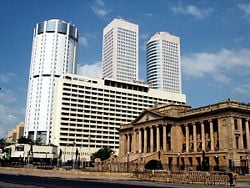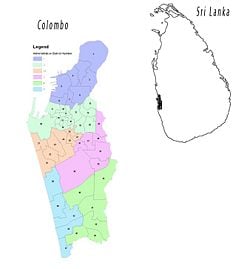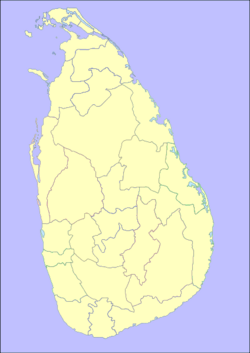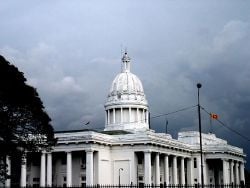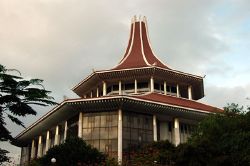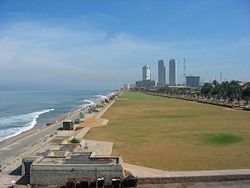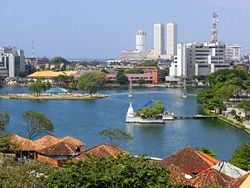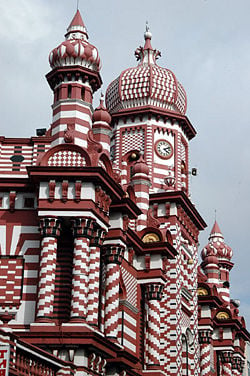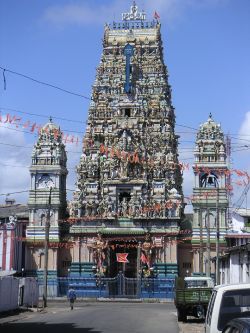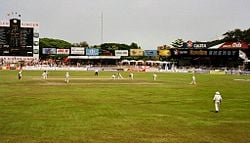Difference between revisions of "Colombo" - New World Encyclopedia
Mike Butler (talk | contribs) |
Mike Butler (talk | contribs) |
||
| Line 44: | Line 44: | ||
Colombo's geography is a mix of land and water. The city has many canals and, in the heart of the city, the {{convert|65|ha|acre|adj=on|lk=on}} [[Beira Lake]].<ref name='limc'>[http://www.lankalibrary.com/phpBB/viewtopic.php?t=1799 The lake in the middle of Colombo], ''Lanka Library''</ref> The lake is one of the most distinctive landmarks of Colombo, and was used for centuries by colonists to defend the city.<ref name='limc'/> It remains a popular attraction, hosting [[regattas]],<ref>''[http://www.dailynews.lk/2003/10/25/spo03.html 35th boat race and 31st Regatta: Oarsmen of Royal and S. Thomas' clash on Beira waters], ''Daily News'', October 10, 2003</ref> and [[theater|theatrical events]] on its shores. The Northern and North-Eastern border of the city of Colombo is formed by the [[Kelani River]], which meets the sea in a part of the city known as the Modera (''mōdara'' in Sinhala) which means [[river delta]]. | Colombo's geography is a mix of land and water. The city has many canals and, in the heart of the city, the {{convert|65|ha|acre|adj=on|lk=on}} [[Beira Lake]].<ref name='limc'>[http://www.lankalibrary.com/phpBB/viewtopic.php?t=1799 The lake in the middle of Colombo], ''Lanka Library''</ref> The lake is one of the most distinctive landmarks of Colombo, and was used for centuries by colonists to defend the city.<ref name='limc'/> It remains a popular attraction, hosting [[regattas]],<ref>''[http://www.dailynews.lk/2003/10/25/spo03.html 35th boat race and 31st Regatta: Oarsmen of Royal and S. Thomas' clash on Beira waters], ''Daily News'', October 10, 2003</ref> and [[theater|theatrical events]] on its shores. The Northern and North-Eastern border of the city of Colombo is formed by the [[Kelani River]], which meets the sea in a part of the city known as the Modera (''mōdara'' in Sinhala) which means [[river delta]]. | ||
| − | |||
| − | |||
Colombo’s climate is fairly temperate all throughout the year. From March to April the temperature averages around 88°F (31°C) maximum. Colombo sees little relative diurnal range of temperature, although this is more marked in the drier winter months, where minimum temperatures average 72°F (22°C). The only change occurs during the [[monsoon]] seasons from May to August, and October to January, when heavy rains can be expected. Mean annual precipitation is 94 inches (2400mm). | Colombo’s climate is fairly temperate all throughout the year. From March to April the temperature averages around 88°F (31°C) maximum. Colombo sees little relative diurnal range of temperature, although this is more marked in the drier winter months, where minimum temperatures average 72°F (22°C). The only change occurs during the [[monsoon]] seasons from May to August, and October to January, when heavy rains can be expected. Mean annual precipitation is 94 inches (2400mm). | ||
| − | + | Environmental issues include coastal degradation from increased pollution, freshwater resources being polluted by industrial wastes and sewage runoff, inadequate waste disposal, and air pollution. | |
| − | Environmental issues | ||
The fort, the fortifications of which are long gone, and the area outside the fort, the Pettah, are the oldest districts. The fort is the center of government and commercial activity. The Pettah has small shops, markets, and sidewalk stalls. Cinnamon Gardens, south of Beira Lake, was where the Dutch grew cinnamon. | The fort, the fortifications of which are long gone, and the area outside the fort, the Pettah, are the oldest districts. The fort is the center of government and commercial activity. The Pettah has small shops, markets, and sidewalk stalls. Cinnamon Gardens, south of Beira Lake, was where the Dutch grew cinnamon. | ||
Revision as of 01:09, 26 August 2008
| Colombo | |||
| The skyline of the Fort area. The twin towers of the World Trade Center building are in the background, with the Bank of Ceylon tower to their left and the Presidential Secretariat in the foreground. | |||
|
|||
| Map of Colombo showing its administrative districts. | |||
| Map of Colombo showing its administrative districts. | |||
| Coordinates: {{#invoke:Coordinates|coord}}{{#coordinates:6|54|0|N|79|50|0|E|type:city | |||
|---|---|---|---|
| name= }} | |||
| District | Colombo District | ||
| Government | |||
| - Mayor | Uvais Mohamed Imitiyas (Independent) | ||
| - Deputy Mayor | S. Rajendran (Independent Group) | ||
| Area | |||
| - City | 37.31 km² (14.4 sq mi) | ||
| Population (2001[1]) | |||
| - City | 642,163 | ||
| - Density | 17,211/km² (44,576.3/sq mi) | ||
| - Metro | 2,234,000 | ||
| Time zone | Sri Lanka Standard Time Zone (UTC+5:30) | ||
| - Summer (DST) | Summer time (UTC+6) | ||
| Website: www.cmc.lk | |||
Colombo (Sinhala: ![]() , pronounced [ˈkoləmbə]; Tamil: கொழும்பு) is the largest city and commercial capital of Sri Lanka. Located on the west coast of the island and adjacent to Sri Jayawardenepura Kotte, the administrative capital of Sri Lanka, Colombo is a busy and vibrant city with a mixture of modern life and colonial buildings and ruins.
, pronounced [ˈkoləmbə]; Tamil: கொழும்பு) is the largest city and commercial capital of Sri Lanka. Located on the west coast of the island and adjacent to Sri Jayawardenepura Kotte, the administrative capital of Sri Lanka, Colombo is a busy and vibrant city with a mixture of modern life and colonial buildings and ruins.
Due to its large harbour and its strategic position along the East-West sea trade routes, Colombo was known to ancient traders 2000 years ago. However it was only made the capital of the island when Sri Lanka was ceded to the British Empire in 1815,[2] and its status as capital was retained when the nation became independent in 1948. In 1978, when administrative functions were moved to Sri Jayawardenepura Kotte, Colombo was designated as the commercial capital of Sri Lanka.
The main city is home to a majority of the Sri Lanka's corporate offices, restaurants and entertainment venues.[3] Famous landmarks in Colombo include the Galle Face Green, the Viharamahadevi Park as well as the National Museum.
Geography
The name "Colombo", first introduced by the Portuguese in 1505, is believed to be derived from the classical Sinhalese name Kolon thota, meaning "port on the river Kelani".[4] It has also been suggested that the name may be derived from the Sinhalese name Kola-amba-thota which means "Harbor with leafy mango trees".[3][5]
Colombo's geography is a mix of land and water. The city has many canals and, in the heart of the city, the 65-hectare (Template:Convert/LonAonSonNa) Beira Lake.[6] The lake is one of the most distinctive landmarks of Colombo, and was used for centuries by colonists to defend the city.[6] It remains a popular attraction, hosting regattas,[7] and theatrical events on its shores. The Northern and North-Eastern border of the city of Colombo is formed by the Kelani River, which meets the sea in a part of the city known as the Modera (mōdara in Sinhala) which means river delta.
Colombo’s climate is fairly temperate all throughout the year. From March to April the temperature averages around 88°F (31°C) maximum. Colombo sees little relative diurnal range of temperature, although this is more marked in the drier winter months, where minimum temperatures average 72°F (22°C). The only change occurs during the monsoon seasons from May to August, and October to January, when heavy rains can be expected. Mean annual precipitation is 94 inches (2400mm).
Environmental issues include coastal degradation from increased pollution, freshwater resources being polluted by industrial wastes and sewage runoff, inadequate waste disposal, and air pollution.
The fort, the fortifications of which are long gone, and the area outside the fort, the Pettah, are the oldest districts. The fort is the center of government and commercial activity. The Pettah has small shops, markets, and sidewalk stalls. Cinnamon Gardens, south of Beira Lake, was where the Dutch grew cinnamon.
History
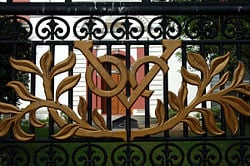
As Colombo possesses a natural harbour, it was known to Romans, Arabs, and Chinese traders over 2,000 years ago. Traveller Ibn Batuta who visited the island in the 14th century, referred to it as Kalanpu.[8] Arabian Muslims whose prime interests were trade, began to settle in Colombo around the 8th century CE mostly because the port helped their business and controlled much of the trade between the Sinhalese kingdoms and the outside world. They now comprise the local Sri Lankan Moor community. [2][9]
The Portuguese Era
Portuguese explorers led by Dom Lourenço de Almeida first arrived in Sri Lanka in 1505. During their initial visit they made a treaty with the King of Kotte Parakramabahu VIII (1484-1508) enabling them to trade in the islands' crop of cinnamon, which lay along the coastal areas of the island, including in Colombo.[10] As part of the treaty, the Portuguese were given full authority over the coast line in exchange for the promise of guarding the coast against invaders. They were also allowed to establish a trading post in Colombo.[10] Within a short time, however, they then expelled the Muslim inhabitants of Colombo and began to build a fort there in 1517.
The Portuguese soon realized that control of Sri Lanka was necessary for protection of their coastal establishments in India and they began to manipulate the rulers of the Kotte Kingdom in order to gain control of the area. After skilfully exploiting rivalries within the Royal Family, they took control of a large area of the Kingdom and the Sinhalese King Mayadunne established a new Kingdom at Sitawaka, a domain in the Kotte kingdom.[10] Before long he annexed much of the Kotte kingdom and forced the Portuguese to retreat to Colombo, which was repeatedly besieged by Mayadunne and the later Kings of Sitawaka, forcing them to seek reinforcement from their major base in Goa, India. However, following the fall of the Kingdom in 1593, the Portuguese were able to establish complete control over the entire coastal area, with Colombo as their capital.[10][11]
This part of Colombo is still known as Fort and houses the presidential palace and the majority of Colombo's five star hotels. The area immediately outside Fort is known as Pettah (Sinhala piṭa koṭuva, "outer fort") and is a commercial hub.
The Dutch Era
In 1638 the Dutch signed a treaty with King Rajasinha II of Kandy which assured the king assistance in his war against the Portuguese in exchange for a monopoly of the island's major trade goods. The Portuguese resisted the Dutch and the Kandyans, but were gradually defeated in their strongholds beginning in 1639.[12] The Dutch captured Colombo in 1656 after an epic siege, at the end of which a mere 93 Portuguese survivors were given safe conduct out of the fort. Although the Dutch initially restored the captured area back to the Sinhalese Kings, they later refused to turn them over and gained control over the island's richest cinnamon lands including Colombo which then served as the capital of the Dutch maritime provinces under the control of the Dutch East India Company until 1796.[12][13]
The British era
Although the British captured Colombo in 1796, it remained a British military outpost until the Kandyan Kingdom was ceded to them in 1815 and they made Colombo the capital of their newly created crown colony of Ceylon. Unlike the Portuguese and Dutch before them, whose primary use of Colombo was as a military fort, the British began constructing houses and other civilian structures around the fort, giving rise to the current City of Colombo.[2]
Initially, they placed the administration of the city under a "Collector", and John Macdowell of the Madras Service was the first to hold the office. Then, in 1833, the Government Agent of the Western Province was charged with the administration of the city. Centuries of colonial rule had meant a decline of indigenous administration of Colombo, and in 1865 the British conceived a Municipal Council as a means of training the local population in self-governance. The Legislative Council of Ceylon constituted the Colombo Municipal Council in 1865 and the Council met for the first time on the January 16, 1866. At the time, the population of the region was around 80,000.[2]
During the time they were in control of the Colombo, the British were responsible for much of the planning of the present city. In some parts of the city tram car tracks and granite flooring laid during the era are still visible today.[14][15]
Post independence
This era of colonialism ended peacefully in 1948 when Ceylon gained independence from Britain.[16] Due to the tremendous impact this caused on the city's inhabitants and on the country as a whole, the changes that resulted at the end of the colonial period were drastic. An entire new culture took root. Changes in laws and customs, clothing styles, religions and proper names were a significant result of the colonial era.[16] These cultural changes were followed by the strengthening of the island's economy. Even today, the influence of the Portuguese, the Dutch and the British is clearly visible in Colombo’s architecture, names, clothing, food, language and attitudes. Buildings from all three eras stand in their glory as reminders of the turbulent past of Colombo. The city and its people show an interesting mix of European clothing and lifestyles together with local customs.[16] Colombo is by far more modern than most cities in neighbouring countries and continues to be a blossoming metropolis of the East.
Historically, Colombo referred to the area around the Fort and Pettah Market which is famous for the variety of products available as well as the Khan Clock Tower, a local landmark. At present, it refers to the city limits of the Colombo Municipal Council. More often, the name is used for the Conurbation known as Greater Colombo, which encompasses several Municipal councils including Kotte, Dehiwela and Colombo.
Although Colombo lost its status as the capital of Sri Lanka in the 1980s, it continues to be the island's commercial centre. Despite the official capital of Sri Lanka moving to the adjacent Sri Jayawardanapura Kotte, most countries still maintain their diplomatic missions in Colombo.[17]
Government
Local Government
Like many cities, Colombo's urban area extends well beyond the boundaries of a single local authority, encompassing other Municipal and Urban Councils.
Colombo is a charter city, with a Mayor Council form of government. Colombo's mayor and the council members are elected through local government elections held once in five years. For the past 50 years the city had been ruled by the United National Party (UNP), a right leaning party, whose business friendly policies resonate with the population of Colombo. However the UNP nomination list for the 2006 Municipal elections was rejected,[18] and an Independent Group supported by the UNP won the elections.[19] Uvais Mohamed Imitiyas was subsequently appointed Mayor of Colombo.[20]
The city government provides sewer, road management and waste management services, in case of water, electricity and telephone utility services the council liaises with the water supply and drainage board, the Ceylon electricity board and telephone service providers.
- Official Vision and mission
Vision:
| “ | Colombo being a model city in Asia, a caring organization looking after interests of citizens and users with an efficient quality service for creation of safe, healthy and wealthy life.[21] | ” |
Mission
| “ | Organization achieving excellence in providing citizen centered services to the public / customer, optimizing the use of available resources through a competent, motivated and dedicated team.[21] | ” |
Law enforcement & Crime
The Sri Lanka Police the main law enforcement agency of the island liaise with the municipal council, but is under the control of the Ministry of Defence of the central government[22]. Policing in Colombo and its suburbs falls within the Metropolitan Range headed by the Deputy Inspector General of Police (Metropolitan), this also includes the Colombo Crime Division[23]. As with most Sri Lankan cities, the magistrate court handles felony crimes, the district court handles civil cases.
As in other large cities around the world, Colombo experiences cretin levels of street crime and bribery. In addition, in since the 1980's there has been a number of major terrorist attacks[24][25]. The LTTE has been linked to bombings and assassinations in the city[26]. Welikada Prison is situated in Colombo and it is the one of the largest maximum security Prisons in the country[27].
National capital
Colombo was the capital of the coastal areas controlled by the Portuguese, Dutch and the British from the 1700s to the 1815 when the British gained control of the entire island following the Kandian convention. Since then till the 1980's the national capital of the island was Colombo. During the 1980's plans were made to move the administrative capital to Sri Jayawardanapura Kotte and thus move all governmental institutions out of Colombo to make way for commercial activities. As a primary setp the Parliament was moved to a new complex in Kotte and several ministries and departments were also moved. However the move was never completed. Today many governmental institutions still remain in Colombo. These include the President's House, Presidential Secretariat, Prime Minister's House (Temple Trees), Prime Minister's Office, the Supreme Court of Sri Lanka, Central Bank of Sri Lanka, important government ministries and departments; such as Finance (Treasury), Defence, Home affairs, Foreign affairs, Public Administration, Justice and the Military headquarters, Naval headquarters (SLNS Ranagala), Air Force headquarters (SLAF Colombo) and Police national and field force headquarters.[28][29]
Economy
The great majority of Sri Lankan corporations have their head offices in Colombo. Some of the industries include chemicals, textiles, glass, cement, leather goods, furniture, and jewelry. In the city center is located South Asia's second tallest building - The World Trade Center. The 40 story Twin Tower complex is the centre of important commercial establishments, situated in the Fort district, the city's nerve center. Right outside the Fort area is Pettah which is derived from the Sinhalese word pita which means out or outside as it is outside the Fort.
Pettah is more crowded than the fort area. It's a place you can buy almost anything you want, Pettah's roads are always packed and pavements are full of small stalls selling from delicious Sharbat to Shirts. Main Street consists mostly of clothes shops and the cross roads, which are literally known as Cross Streets where each of the five streets specializes in a specific business. For example the first cross street mostly comprises electronic goods shops, the second cellular phones and fancy goods. Most of these businesses in Pettah are dominated by Muslim traders. At the end of the main street further away from Fort is the Sea Street, Sri Lanka's Gold market. This mile-long street is full of jewellery shops.
The Colombo Metropolitan Region (CMR) encompasses the country's administrative capital Kotte and Colombo. Found within the borders of the CMR is 80% of the country’s industrialization and over 60% of all vehicles plying Sri Lankan roads.
Colombo has most of the amneties that a modern city has. The majority of the major shopping malls in Sri Lanka are located in the city, of which all are wi-fi enabled. In recent times there's been an outpour of high rise condominiums in the city, mainly due to the very high land prices.
Almost all major media businesses in Sri Lanka operate from Colombo. The state media has its offices in Bullers Road and carry out regional transmission from there, this includes the Sri Lanka Broadcasting Corporation (SLBC), formerly known as Radio Ceylon and the Sri Lanka Rupavahini Corporation. The SLBC is the oldest radio station in South Asia. Many of the private broadcasting companies have there offices and transmission stations in or around Colombo.
The city is a popular fashion center in South East Asia today. The industry has evolved to meet modern standards and conducts regular shows to showcase local talent.
Transport
Colombo has an extensive public transport system based on buses, The bus service is operated both by private and government own Sri Lanka Transport Board (SLTB). Train transport within the city is limited since most trains are meant for transport to and from the city rather than within the city and are often overcrowded. However the Central Bus Stand and Fort Railway Station functions as the islands primary hub for bus and rail transport respectively. Up until the 1970's the city had a trams service, which was discontinued. Other means of transport includes auto rickshaws (commonly called "three wheelers" in Sri Lanka) and taxicabs. Three wheelers are entirely operated by individuals and hardly regulated whilst cab services are run by private companies and are metered.
Construction of the Colombo Metro Rail, a Mass Rapid Transit railway system, similar to that of other advanced Asian cities has begun, this is to control the excessive traffic in the city. The project is carried out by NEB Rapid Infrastructure Projects Pvt.Ltd. an Indian and Singaporean collaboration.[30] [31]
Bandaranaike International Airport serves the city for all International flights while the Ratmalana Airport serves all local flights.
Demographics
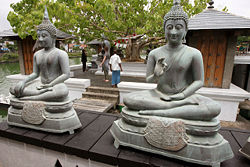
Colombo is the most populated city in Sri Lanka, with 642,163 people living within the city limits.[32]
Colombo is a multi-ethnic, multi-cultural city. The population of Colombo is a mix of numerous ethnic groups, mainly Sinhalese 41.36 percent, Moors 23.87 percent, and Tamils 28.91 percent. There are also small communities of people with Chinese, Portuguese, Dutch, Malay (1.73 percent) and Indian Tamil (2.17 percent) origins living in the city, as well as numerous European expatriates.
Language
Religion
Colleges and universities
Education
After independence in late 1950's the subsequent governments established free education Sri Lanka thus making 13 years of education compulsory for everyone
Most of the urban schools of Sri Lanka have some relgious alignment, this is partly due to the influence of British and Dutch colonization who established Christian missionary schools. [33][34] Continuing this tradition in Colombo and other parts of Sri Lanka there are Buddhist, Hindu, Muslim and Christian schools. This religious alignment does not effect the curriculum of the school except for the demography of the student population [33].
Higher education in the city has a long history, it begins with the Colombo Medical School and the Colombo Law College being established in the 1870s. The first step in the creation of a University in the island was taken in 1913 with the established of the Ceylon University College, this was followed by the formation of the University of Ceylon, which had a campus in Colombo[35]. Today the University of Colombo and the University of the Visual & Performing Arts are state universities in the city. The Sri Lanka Institute of Information Technology also has a metropolitan campus in the center of the city. There are several private higher education institutions within the city.
Of interest
This image is a candidate for speedy deletion. It will be deleted after seven days from the date of nomination.
- The Dutch Hospital is the oldest building in the fort area, ; the Dutch House which is now the Colombo Dutch Museum and several churches. The President's House (formal the Queen's House) add original been the Dutch governors house and successive British Governors made it their office and residence, however it has under gone much change since the Dutch period. Adjoining the President's House is the Gordon Gardens, now off-limits to the public.
- Notable commercial buildings of the British era include, the Galle Face Hotel, Cargills & Millers complex, Grand Oriental Hotel. Several old clubs of the city gives a glimpse of the British equestrian life style, these include the Orient Club, the 80s Club, the Colombo Cricket Club.
- Buildings of the British era include the old Parliament building which is now the Presidential Secretariat, the Republic Building which houses the Ministry of Foreign affairs, but once housed the Ceylon Legislative council, the Treasury building, the old General Post Office an Edwardian style building opposite the President's House, the Prime Minister's Office, the Mathematics department of the University of Colombo (formally the Royal College, Colombo)
The two World Trade Center towers use to be the most recognized landmarks of the city. Before these towers were completed in 1997, the adjacent Bank of Ceylon tower was the tallest structure and the most prominent landmark of the city. Before the skyscrapers were built it was the Old Parliament Building that stood majestically in the Fort district with the Old Colombo Lighthouse situated close to it. Another important landmark of the city is the Independence Hall at Independence Square in Cinnamon gardens.
Even before the parliament was built some claim that the Jami Ul-Alfar Mosque was recognized as the landmark of Colombo by sailors approaching the port. The mosque is still one of the most visited tourist sites in Colombo.
The Fort district also has the famous Cargills & Millers complex that is protected by a special government law from demolition. This is done mainly to preserve the historic beauty of the Fort area.
The Galle Face Green is the city's largest and most elegant promenade. Lined with palm trees and adjacent to the coast, this mile-long stretch in the heart of the city is a constant beehive of activity. The green is especially busy on Fridays and Saturdays. In the evenings it plays host to families and children playing sports and flying kites, lovers embracing under umbrellas and health enthusiasts taking their daily evening walks. There are numerous small food stalls and a small stretch of beach to get wet. The green was recently given a make over and since then has been even more popular with the local community. The Green also frequently hosts numerous international and local concerts and performances, such as the recently concluded World Drum Festival.
Cannons that were once mounted on the rampart of the old fort of Colombo laid out for observance and prestige at the Green, giving a colonial touch to the city. The famous colonial styled Galle Face Hotel, known as Asia's Emerald on the Green since 1864, is also adjacent to Galle Face Green. The Hotel has played host to distinguished guests including the British Royal Family and other Royal Guests and Celebrities. Apparently after having stayed at the hotel, Princess Alexandra of Denmark had commented that "the peacefulness and generosity encountered at the Galle Face Hotel cannot be matched".[36] Around the corner from Galle Face are prominent coffee bars, chic bars and boutiques.
Architecture
Colombo has wildly varying architecture, spanning centuries, however both the old and new coexists side by side. Now other place is this more evident in the heart of the city the Fort area. Here one may find new towering skyscrapers as well as historic buildings dating far back as the 1700's[37][38].
Annual cultural events and fairs
Colombo's most beautiful festival is the celebration of Lord Buddha's Birth, Enlightenment and Death all falling on the same day.[39]In Sinhala this is known as Vesak. [39] During this festival, much of the city is decorated with lanterns, lights and special displays of light(known as Thoran). The festival falls in mid May and lasts a week when many Sri Lankans visit the city to see the lantern competitions and decorations. During this week people distribute, rice, drinks and various other food items for free in places what is known as Dunsal which means charity place. These Dunsals are popular amongst visitors from the suburbs.
Christmas is another major festival in the city. Although Sri Lanka's Christians make up only just over 7% of the population, Christmas is one of the island's biggest festivals. Most streets and commercial buildings light up from the beginning of December and festive sales begin at all shopping centres and department stores. Caroling and nativity plays are also frequent sights during the season.
Performing arts
Colombo has several performing arts centers which are popular for their musical and theatrical performances. The most famous performing arts centers are the Lionel Wendt Theater, the Elphinstone and the Tower Hall, all of which have a very rich history and made for western style productions. The Navarangahala also found in the city is the country's first national theatre designed and build for Asiatic and local style musical and theatrical productions.
Museums and art collections
The National Museum of Colombo, was established on 1st of January ,1877 during the tenure of the British Colonial Governor Sir William Henry Gregory is situated in cinnamon gardens area. Next to it is the Natural History Museum.[40]The museum houses the crown jewels and throne of the last king of the Kingdom of Kandy, Sri Vikrama Rajasinha.[40]. There is also the Colombo Dutch Museum detailing the Dutch colonial history of the country. Colombo does not boast a very big art gallery. There is only a small collection of Sri Lankan masterpieces at the Art Gallery in Green Path.
Sports
Undoubtedly the most popular sport in Sri Lanka is cricket. The country emerged as champions of the 1996 Cricket World Cup and became runners up in 2007. The sport is played in parks, playgrounds, beaches and even in the streets of the city. Colombo is also the home for two of the country's international cricket stadiums, Sinhalese Sports Club's cricket stadium and R. Premadasa Stadium (named after late president Premadasa). Rugby is also a popular sport at the club and school level. Colombo has the distinction of being the only city in the world to have 4 cricket Test venues in the past: P. Saravanamuttu Stadium, Sinhalese Sports Club Ground, Colombo Cricket Club Ground and Ranasinghe Premadasa Stadium. The Sugathadasa Stadium situated in the city, is an international standard stadium for athletics, swimming and football, also held the South Asian Games in 1991 and 2006.
The city of Colombo also has its own local football team Colombo FC and the sport is being developed as a part of the FIFA Goal program.
Notes
- ↑ Census July 17, 2001 (via citypopulation.de)
- ↑ 2.0 2.1 2.2 2.3 History of Colombo. Retrieved 2007-03-21.
- ↑ 3.0 3.1 World Executive Colombo Hotels and City Guide
- ↑ "Colombo - then and now", Padma Edirisinghe, The Sunday Observer, 14 February, 2004.
- ↑ Jayewardene, Mr.. How Colombo Derived its Name. Retrieved 2007-01-18.
- ↑ 6.0 6.1 The lake in the middle of Colombo, Lanka Library
- ↑ 35th boat race and 31st Regatta: Oarsmen of Royal and S. Thomas' clash on Beira waters, Daily News, October 10, 2003
- ↑ John, Still (1996). Index to the Mahawansa:Together with Chronological Table of Wars and Genealogical Trees. AES, 85. ISBN 81-206-1203-5.
- ↑ Prof. Manawadu, Samitha. Cultural Routes Of Sri Lanka As Extensions Of International Itineraries : Identification Of Their Impacts On Tangible & Intangible Heritage pp 3 (pdf). Retrieved 2007-01-17.
- ↑ 10.0 10.1 10.2 10.3 European Encroachment and Dominance:The Portuguese (html). Sri Lanka: A Country Study. Retrieved 2006-12-02.
- ↑ Ross,, Russell R. and Savada, Andrea Matles (08/14/90). Sri Lanka: A Country Study. Defence Dept., Army, 360p. ISBN 0-16-024055-7.
- ↑ 12.0 12.1 European Encroachment and Dominance:The Dutch (html). Sri Lanka: A Country study. Retrieved 2006-12-02.
- ↑ Ross,, Russell R. and Savada, Andrea Matles (08/14/90). Sri Lanka: A Country Study. Defense Dept., Army, 360p. ISBN 0-16-024055-7.
- ↑ Ross,, Russell R. and Savada, Andrea Matles (08/14/90). Sri Lanka: A Country Study. Defense Dept., Army, 360p. ISBN 0-16-024055-7.
- ↑ European Encroachment and Dominance:The British Replace the Dutch (html). Sri Lanka: A Country study. Retrieved 2006-12-02.
- ↑ 16.0 16.1 16.2 Adrian, Wijemanne (03/1/96). War and Peace in Post-Colonial Ceylon 1948-1991. Orient Longman, 111p. ISBN 8125003649.
- ↑ GoAbroad.com, Embassies located in Sri Lanka
- ↑ Colombo UNP list rejected, BBC News, February 16, 2006
- ↑ Independent group wins CMC, BBC News, May 21, 2006
- ↑ Rotational mayors as Colombo gets trishaw driver as her 1st citizen, Sunday Times, May 28, 2006
- ↑ 21.0 21.1 Colombo Municipal, Council. Mission & Vision. Retrieved 2007-01-18.
- ↑ Organizational Structure, Ministry of Defence, Sri Lanka
- ↑ The drama behind the arrest of Sepala Eknayake, by Edward Gunawardena Retd. Senior Deputy Inspector General of Police
- ↑ Major Conventional Terrorist Incidents 1980s to 2000
- ↑ Travel Warning, United States Department of State
- ↑ Jane's Sentinel examines the success of the LTTE in resisting the Sri Lankan forces
- ↑ President orders SB`s release, LankaNewspapers.com, February 16, 2006
- ↑ The Supreme Court Of Sri Lanka, Justice Ministry
- ↑ Ministries of Sri Lanka Government, Government of Sri Lanka
- ↑ Lanka Business Online. Light Rail. Retrieved 2007-03-21.
- ↑ Lanka Business Online. Light Rail Study Group. Retrieved 2007-03-21.
- ↑ Cite error: Invalid
<ref>tag; no text was provided for refs namedcen01 - ↑ 33.0 33.1 Cite error: Invalid
<ref>tag; no text was provided for refs namededu - ↑ Cite error: Invalid
<ref>tag; no text was provided for refs namededu2 - ↑ History of the University of Colombo
- ↑ Galle Face, Hotel. Princess Alexandra's Visit (html). Retrieved 2007-02-23.
- ↑ Colombo Fort
- ↑ Tintagel, Colombo
- ↑ 39.0 39.1 Venerable Mahinda. Significance of Vesak (html). www.buddhanet.net. Retrieved 2007-02-19.
- ↑ 40.0 40.1 History of Colombo National Museum. Retrieved 2007-02-02. Cite error: Invalid
<ref>tag; name "Mus" defined multiple times with different content
Further reading
The following books contain major components on colombo;
- Changing Face of Colombo (1501-1972): Covering the Portuguese, Dutch and British Periods, By R.L. Brohier, 1984 (Lake House, Colombo)
- The Port of Colombo 1860-1939, K. Dharmasena, 1980 (Lake House, Colombo)
- Decolonizing Ceylon: Colonialism, Nationalism, and the Politics of Space in Sri Lanka, By Nihal Perera, 1999 (Oxford University Press)
[1]. As per the world bank and UNESCO reports 96% of the population have at least completed primary education [1] [2] Colombo has many of the prominent public schools in the country some of them government owned and others are private. [3].
See also
- Colombo Town Guard
- List of tallest buildings and structures in Sri Lanka
- Place names in Sri Lanka
- South Asian capitals
External links
- Encyclopaedia Britannica Colombo Retrieved August 26, 2008.
- Lanka Media Information
- Colombo Municipal Council, History of the City
- Searchable map of Colombo and Sri Lanka
- Historic photographs of Sri Lanka - City of Colombo
-
- Mapping from Multimap or GlobalGuide or Google Maps
- Satellite image from WikiMapia
- Mapping from OpenStreetMap
Template:Sri Lankan Urban Councils
| ||||||||||
| |||||||
Credits
New World Encyclopedia writers and editors rewrote and completed the Wikipedia article in accordance with New World Encyclopedia standards. This article abides by terms of the Creative Commons CC-by-sa 3.0 License (CC-by-sa), which may be used and disseminated with proper attribution. Credit is due under the terms of this license that can reference both the New World Encyclopedia contributors and the selfless volunteer contributors of the Wikimedia Foundation. To cite this article click here for a list of acceptable citing formats.The history of earlier contributions by wikipedians is accessible to researchers here:
The history of this article since it was imported to New World Encyclopedia:
Note: Some restrictions may apply to use of individual images which are separately licensed.
- ↑ 1.0 1.1 Harsha, Aturupane; Paul Glewwe, Wisniewski Suzanne (July,2007). The Impact of School Quality, Socio-Economic Factors and Child Health on Students’ Academic Performance: Evidence from Sri Lankan Primary Schools (pdf). World Bank. Retrieved 2007-07-27.
- ↑ Education in Sri Lanka (html). UNESCO Institute for Statistics (2006). Retrieved 2007-07-27.
- ↑ Harsha, Aturupane and Paul Glewwe, Wisniewski Suzanne (February,2005). TREASURES OF THE EDUCATION SYSTEM IN SRI LANKA:RESTORING PERFORMANCE,EXPANDING OPPORTUNITIES AND ENHANCING PROSPECTS (pdf), Colombo: World Bank. Retrieved 2007-07-27.
